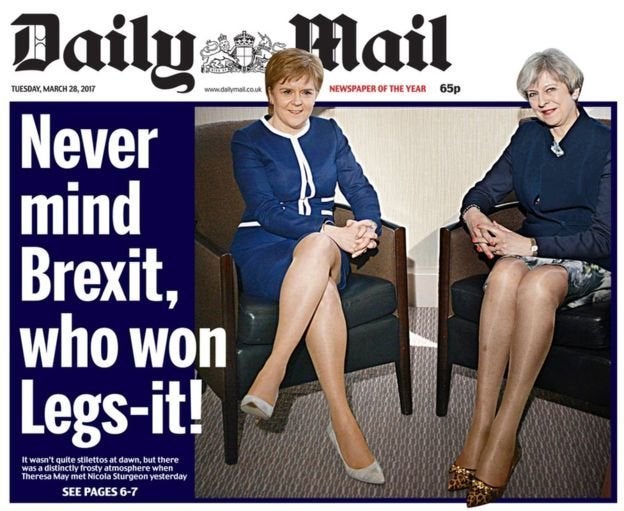
The “woeful” lack of women in senior roles or writing front page stories at UK newspapers has been laid bare in a startling new report.
Between June and July of this year, just 25% of front page bylines at national British newspapers were women’s while a paltry 34% of senior managers were female.
The study by Women In Journalism also shone a light on the type of assignments female journalists were handed “soft” stories in areas such as royalty, showbusiness and health, while male reporters were allocated the hard news on crime, politics and major incidents.
According to the WIJ analysis, the worst papers for front page bylines by women were:
The Daily Mirror - 10%
The Evening Standard and The Sun - 15%
The Daily Express - 16%
Coverage of the General Election, London terror attacks and Grenfell Tower fire tragedy was dominated by men.
Just three UK national newspapers have female editors: the Guardian, the Daily Star and The Sun on Sunday.
Only three newspapers have women running their news desks: Metro, The Times and The Sunday Times. Just one, the Daily Star, has a woman in charge of their backbench, where most decisions are made, while Metro has a woman as night editor.

The Guardian, edited by Katharine Viner, was the best for female bylines, with 43% of front page stories written by women - almost double the proportion of female bylines compared to WIJ’s 2012 research, when Alan Rusbridger was still at the helm.
Second to the Guardian was the Telegraph, followed by the Financial Times. The Daily Mail had more female bylines than the Mirror, The Express, Metro, The Sun and The Times.
Most news desks, which assign stories to reporters, are run by men, with the exception of The Times, Sunday Times and Metro.
With the research covering the period of the General Election, shadow culture secretary Tom Watson has called for the Parliamentary lobby, the group of journalists which cover politics from Westminster to “get its house in order” and send more women to cover important stories.
He said: “This new research showing the woeful underrepresentation of women in British journalism should set alarm bells ringing for readers as well as reporters and editors across the country.
“Who writes and decides the news matters, and it is not good enough that just 25 percent of front page bylines are by women, and just 34 percent of senior roles at national newspapers are held by women.
“The painfully slow improvement in representation since the last report in 2012, up just two percentage points, shows the industry is failing to recognise and respond to the problem.

“Political journalism is among the worst offenders, and I’d like to issue a challenge today, that by the next report the Parliamentary Lobby gets its house in order and achieves gender parity among political journalists.
“A free and fair press is one of the pillars of our democracy, but these figures show that if you’re a woman, you won’t have a fair chance at a career in journalism. The industry must make it a priority to change that.”
A spokeswoman for WIJ said the dominance of men at a management level also affected how stories were covered, singling out the Daily Mail’s ‘Legsit’ front page as an example of a “predominantly old, white, male gaze” influence in the newsroom.
The report said: “Particularly egregious examples of this distorting lens include ‘Leg-sit’ – how the Daily Mail described the meeting of Theresa May and Nicola Sturgeon, the two most powerful political leaders in the country on March 26, 2017.
“Or how David Cameron’s decision to appoint more women to his cabinet on July 16, 2014, was treated as an excuse to picture the new female ministers on a ‘Downing Street Catwalk’ where their outfits were critiqued. Both examples
reinforce to the public that no matter how powerful a woman is, or how impressive her credentials are for doing a job, it is her appearance that matters more than anything.
“Both examples reinforce to the public that no matter how powerful a woman is, or how impressive her credentials are for doing a job, it is her appearance that matters more than anything.”
Newspapers were falling behind broadcasters on female representation, the WIJ report said.

A House of Lords report into Women and Broadcasting in 2015, which highlighted a lack of presenters and female experts, has led to some change, with it now deemed unacceptable to have an all-male panel on shows such as Question Time.
The WIJ report concluded by calling for newspapers outlets to do more to reflect the diverse nature of the country, adding: “Women are still judged on their appearance, or most likely to appear as victims or arm candy.
“WIJ wants to see more stories about women with agency: doing things in their own right, as more and more women reach powerful positions in our society, they deserve a media culture which gives them a fair crack of the whip and doesn’t judge them by outdated, male metrics.”
It added: “In newspapers the gender bias is more hidden - particularly when it comes to the dearth of women in the parliamentary lobby, in business coverage and on hard news stories, and where decisions are made - which is why we decided to shine a light on the problem.
“Journalism is the first draft of history - it is unacceptable in the 21st century that the big stories are still overwhelmingly written by men, that journalism is still delivered through the male lens. We hope that by airing this often hidden issue and committing to continue to monitor progress, that will change.”
